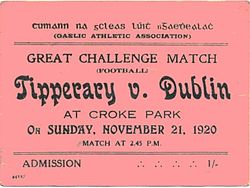 A rare GAA Gaelic football match ticket for a game between Tipperary and Dublin and which was played on “Bloody Sunday,” November 21st 1920, goes on sale next week.
A rare GAA Gaelic football match ticket for a game between Tipperary and Dublin and which was played on “Bloody Sunday,” November 21st 1920, goes on sale next week.
The ticket is one of only a handful still in existence from that infamous football game held in Croke Park, in which 14 people were killed and 60 wounded, after British soldiers fired on attending spectators and players.
This rare ticket, in fine condition, is attracting huge International attention and is expected to be sold at between €5,000 – €30,000, during a two day auction tomorrow (13th) and Tuesday 14th February, in Foley’s Auction Rooms, Sixmilebridge, Co. Clare.
The story of Bloody Sunday 1920 is a tale of extreme violence in Dublin during the Irish War of Independence, when a total of 31 people, fourteen British, fourteen Irish civilians and three republican prisoners were killed.
The day had begun with an Irish Republican Army’s (IRA) operation, under the direction of Michael Collins and Richard Mulcahy, to assassinate the “Cairo Gang,“or “Special Gang,” and others, using a clandestine group of IRA members known as the “The Twelve Apostles.”
 The “Cairo Gang,“or “Special Gang,” were a team of undercover British agents working and living in Dublin. Twelve were British Army officers, one a member of the Royal Irish Constabulary and the last a civilian informant. In the end, of the 35 people originally on Collins’ hit list, only about a third were assisinated, however the action would terrify and cripple British intelligence here in Ireland.
The “Cairo Gang,“or “Special Gang,” were a team of undercover British agents working and living in Dublin. Twelve were British Army officers, one a member of the Royal Irish Constabulary and the last a civilian informant. In the end, of the 35 people originally on Collins’ hit list, only about a third were assisinated, however the action would terrify and cripple British intelligence here in Ireland.
In retaliation for this IRA action, the Royal Irish Constabulary opened fire on a crowd attending a Gaelic football match in Croke Park, killing fourteen civilians. Some police fired into the fleeing crowd, while others outside the Park, opened fire from the Canal Bridge at spectators who climbed over the Canal end wall in their attempt to escape. When the firing stopped seven people had been shot to death, five more had been fatally wounded and another two people lay trampled to death by the fleeing crowd. The dead included two boys aged 10 and 11 years and Tipperary Gaelic football player Michael Hogan, a native of Grandemockler, Co Tipperary. Hogan’s name was memorialised posthumously by the building of the Hogan Stand at Croke Park, in 1924. Later that evening, three IRA suspects in Dublin Castle were beaten and killed by their British captors, allegedly while trying to escape.
The picture of the “Cairo Gang,” or the Special Gang F Company Auxiliaries, is shown left above courtesy of St. Mary’s Famine & War Museum, Thurles, Co.Tipperary. Members of the group got their name originally from British Intellegance, due to the fact that they were ordered not to go near their headquarters in Dublin Castle, but to report all information gleaned, to Colonel Ormonde Winter, on a daily basis at various selected centres, including the Cairo Café, then situated at No 59 Grafton Street, Dublin.
Who Were The Cairo Gang
We can not be totally sure, but according to Military Archives contained in a scrapbook of I.R.A. intelligence, held in Dublin, the names associated to the numbers on the photo are shown hereunder. However it should be noted that on close examination of the photo other numbers can be observed in a lighter shade than the darker version. (Click on photo image for larger resolution to view)
The abbreviations ADRIC, below, stand for Auxiliary Division Royal Irish Constabulary, a paramilitary organization within the Royal Irish Constabulary (RIC) during the Irish War of Independence.
- Richard Dentith, (ADRIC No 1017) later wounded at Pearse street on the 14th Mar 1921. A number of IRA volunteers are captured during this ambush and one of them, Thomas Traynor, was hung on April 25th 1921. On the day following Traynor’s execution, Gilbert Potter an RIC District Inspector based in Cahir, Co. Tipperary, who was being held as hostage for Traynor’s safe treatment, was murdered in reprisal. Dentith died in 1974 in Lancashire.
- Albert Ferguson Fletcher, (ADRIC No 890).
- Frederick Moore, (ADRIC No 393) was a native of Surrey.
- Stanley Dodd Swaffer, (ADRIC No 234) died in Kent, England in June of 1984.
- Cecil Beck Dove, (ADRIC No 667 ) native of Northumberland, died in Eastbourne on Nov 15th 1969.
- Leonard George Appleford, (ADRIC No 589) – Section Leader, native of Harold Wood Essex was shot and killed on the 24th of June 1921 in Dublin.
- Herbert Frederick Gorman, (ADRIC No 625) Died Brent 1974.
- Arthur Winch, (ADRIC No 888) died September 10th 1941.
- Donald F McClean (ADRIC No 588).
- George Aubrey Stapley, (ADRIC No 33) Buxted, Sussex, Died in Chelsea 1964.
An eleventh member partially hidden seated on a window ledge behind the group, remains unidentified.(possibly Captain Patrick McCormack.)
An original laced leather Football, said to have been used at Croke Park during the same Football Challenge Match between Tipperary and Dublin on 21st November, 1920 was sold by James Adam’s & Sons, specialists auctioneers for €26,000 in 2009.

Leave a Reply